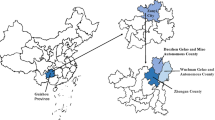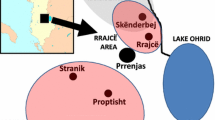Abstract
An ethnobotanical field study was carried out in one of the most remote and poorest areas of Europe: the village of Theth, which is located in the upper Shala Valley in the Northern Albanian Alps. In this study, seventy-nine botanical taxa known and used by the local population were recorded in interviews with thirty-two informants. Among the local food species recorded, the most highly sought after were Prunus cerasifera Ehrh. and Cornus mas L. fruits, which are used for producing home-made raki. A few elderly women in the village still gather wild greens (Urtica, Chenopodium, Amaranthus, and Rumex species), which are used as fillings for home-made pies (byrekë and laknur). Diverse vegetables (cabbage, turnips, tomatoes, peppers, and egg plants) are cultivated and harvested in spring and summer, and are conserved mainly via lacto-fermentation for consumption during the winter. Despite an almost total lack of medical assistance, the villagers of Theth gather only a few medicinal herbs on a regular basis, which they use internally to treat diverse minor ailments. These include the aerial parts of Origanum vulgare L., Hypericum maculatum Crantz, Agrimonia eupatoria L., and the roots of Gentiana lutea L. The findings from this field study could eventually stimulate sustainable plant gathering and harvesting activities in Theth for small-scale trade of a few food, medicinal, and handicraft products.





Similar content being viewed by others
References
AAA/American Anthropological Association (1998) Code of ethics of the American Anthropological Association. AAA, Arlington, VA (USA). Available at: http://www.aaanet.org/committees/ethics/ethcode.htm (accessed July 2007)
Alexiades MN, Sheldon JW (1999) Selected guidelines for ethnobotanical research: a field manual. The New York Botanical Garden, New York, USA
Betti G, Neri L, Bellini F (2003) Poverty and inequality mapping in Albania. Final report. Word Bank and INSTAT, Tirana
BPPP (2007) Balkans Peace Park Project. Available at: http://www.balkanspeacepark.org/index.php (accessed July, 2007)
Carletto C, Davis B, Stampini M, Zezza A (2006) A country on the move: international migration in post-communist Albania. Int Migr Rev 40:767–785
Cotton CM (1996) Ethnobotany: principles and applications. Wiley, Chichester, UK
Deffontaines JP (2005) The terroir, a concept with multiple meanings. In: Bérard L, Cegarra M, Djama M, Louafi S, Marchenay P, Roussel B, Verdeaux F (eds) Biodiversity and local ecological knowledge in France. INRA, CIRAD, IDDRI, IFB, Paris, pp 38–43
Galaty M, Lafe O, Tafilica Z (2005) Shala Valley Project. Report of the 2005 field season. Millsaps College, Jackson, MS (USA). Available at: http://www.millsaps.edu/svp/SVP%202005%20Final%20Report.pdf (accessed July 2007)
Ghirardini MP, Carli M, Del Vecchio N, Rovati A, Cova O, Valigi F, Agnetti G, Macconi M, Adamo D, Traina M, Laudini F, Marcheselli I, Caruso N, Gedda T, Donati F, Marzadro A, Russi P, Spaggiari C, Bianco M, Binda R, Barattieri E, Tognacci A, Girardo M, Vaschetti L, Caprino P, Sesti E, Andreozzi G, Coletto E, Belzer G, Pieroni A (2007) The importance of a taste. A comparative study on wild food plant consumption in twenty-one local communities in Italy. J Ethnobiol Ethnomed 3:22
Glück L (1894) Skizzen aus der Volksmedicin und dem medinischen Aberglauben in Bosnien und der Hecegovina. Wiss Mitteilungen aus Bosnien und der Hercegovina 392–454
Guarrera PM (2006) Usi e tradizioni della flora Italiana. Medicina popolare ed etnobotanica. Aracne Editrice, Rome
Hammer K, Pistrick K, Xhuveli L (1995) Development of Albania’s plant genetic resources interwoven with history. Diversity 11:102–104
Hanelt P, Institute of Plant Genetics and Crop Plant Research (eds) (2001) Mansfeld’s encyclopedia of agricultural and horticultural crops (except ornamentals) (6 vols). Springer Verlag, Berlin Heidelberg New York
Hoda P, Zotaj A (2007) Data on Albanian biodiversity and mapping. Available at: www.ecnc.nl/file_handler/documents/original/download/103/Albania.ppt (accessed in August, 2007). Tilburg; The Netherlands: European Centre for Nature Conservation
ICE/International Society of Ethnobiology (1998) Code of ethics. Available at: http://ise.arts.ubc.ca/ethics.html (accessed in July, 2007)
Jarić S, Popović Z, Macukanović-Jocić M, Djurdjević L, Mijatović M, Karadzić B, Mitrović M, Pavlović P (2007) An ethnobotanical study on the usage of wild medicinal herbs from Kopaonik Mountain (Central Serbia). J Ethnopharmacol 111:160–175
Kemp P (1935) Healing ritual. Studies in the technique and tradition of the Southern Slav. Faber and Faber, London, UK
Kulinović MF (1900) Volksaberglauben und Volksheilmittel bei den Muhammedanern und der Hercegovina. Wiss Mittelungen aus Bosnien und der Hercegovina 339–366
Lilek E (1896) Volksaberglauben und volksthümlicher Cultus in Bosnien und der Hercegovina. Wiss Mitteilungen aus Bosnien und der Hercegovina 26–491
Łuczaj Ł, Szymański WM (2007) Wild vascular plants gathered for consumption in the Polish countryside: a review. J Ethnobiol Ethnomed 3:17
Maffi L (ed) (2001) On biocultural diversity. Linking language, knowledge, and the environment. Smithsonian Institution Press, Washington, USA
Maiga A, Diallo D, Fane S, Sanogo R, Smestad Paulsen B, Cisse B (2005) A survey of toxic plants on the market in the district of Bamako, Mali: traditional knowledge compared with a literature search of modern pharmacology and toxicology. J Ethnopharmacol 96:183–193
Maurizio A (1927) Die Geschichte unserer Pflanzennahrung. Verlagsbuchhandlung Paul Parey, Berlin (Reprinted 1979 by Sändig, Wiesbaden, Germany)
Maurizio A (1933) Geschichte der gegorenen Getränke. Verlagsbuchhandlung Paul Parey, Berlin (Reprinted 1970 by Sändig, Wiesbaden, Germany)
Nuri B (2002) Health care systems in transition. Albania. European Observatory on Health Care System/WHO, Copenhagen
Paparisto K, Qosja X (eds) (1988–2000) Flora e Shqipërisë/Flore de L’Albanie, vols. 4. Akademia e Shkecave e Republikes se Shqipërisë, Tirana, Albania
Pardo de Santayana M, Tardío J, Morales R (2005) The gathering and consumption of wild edible plants in the Campoo (Cantabria, Spain). Int J Food Sci Nutr 56:529–542
Pieroni A (2007) People and mountains in Kelmend. Documentation of a field study on traditional knowledge in the northern Albanian Alps. Wageningen University, Wageningen, The Netherlands
Pieroni A (in press) People and plants in Lëpushë. Traditional medicine, local foods, and post communism in a north Albanian village. In Pardo de Santayana M, Pieroni A, Puri R (eds) Ethnobotany in the New Europe. People, health and wild plant resources pools. Berghahn, Oxford, UK
Pieroni A, Vandebroek I (eds) (2007) Traveling plants, cultures, and medicines. The ethnobiology and ethnopharmacy of migrations. Berghahn, Oxford, UK
Pieroni A, Nebel S, Quave C, Münz H, Heinrich M (2002) Ethnopharmacology of liakra, traditional weedy vegetables of the Arbëreshë of the Vulture area in southern Italy. J Ethnopharmacol 81:165–185
Pieroni A, Giusti ME, Münz H, Lenzarini C, Turkovic G, Turkovic A (2003) Ethnobotanical knowledge of the Istro-Romanians of Žejane in Croatia. Fitoterapia 74:710–719
Pieroni A, Price LL, Vandebroek I (2005a). Welcome to Journal of Ethnobiology and Ethnomedicine. J Ethnobiol Ethnomed 1:1
Pieroni A, Dibra B, Grishaj G, Grishaj I, Maçai SG (2005b) Traditional phytotherapy of the Albanians of Lepushe, Northern Albanians Alps. Fitoterapia 76:379–399
Pieroni A, Giusti ME, de Pasquale C, Lenzarini C, Censorii E, Gonzáles-Tejero MR, Sánchez-Rojas CP, Ramiro-Gutiérrez JM, Skoula M, Johnson C, Sarpaki A, Della A, Paraskeva-Hadijchambi D, Hadjichambis A, Hmamouchi M, El-Jorhi S, El-Demerdash M, El-Zayat M, Al-Shahaby O, Houmani Z, Scherazed M (2006) Circum-Mediterranean cultural heritage and medicinal plant uses in traditional animal healthcare: a field survey in eight selected areas within the RUBIA project. J Ethnobiol Ethnomed 2:16
Redzic S (2006) Wild edible plants and their traditional use in the human nutrition in Bosnia-Herzegovina. Ecol Food Nutr 45:189–232
Russell Bernard H (2002) Research methods in anthropology. Qualitative and quantitative approaches. Altamira, Walnut Creek, CA, USA
Schippmann U, Leaman DJ, Cunningham AB (2002) Impact of cultivation and gathering of medicinal plants om biodiversity: Global trends and issues. In FAO: Biodiversity and the ecosystem approach in agriculture, forestry and fisheries. Satellite event on the occasion of the Ninth Regular Session of the Commission on Genetic Resources for Food and Agriculture. Rome, 12–13 October 2002. Inter-Departmental Working Group on Biological Diversity for Food and Agriculture, FAO, Rome. Available at: ftp://ftp.fao.org/docrep/fao/005/aa010e/AA010E00.pdf (last access: August, 2007)
Shkurti S (1997) Der Mythos vom Wandervolk der Albaner. Böhlau, Vienna
Tardío J, Pardo de Santayana M, Morales R (2006) Ethnobotanical review of wild edible plants in Spain. Bot J Linnean Soc 152:27–71
Truhelka C (1894) Die Heilkunde nach volksthümlicher Ueberlieferung mit Auszügen aus einer alten Handschrift. Wiss Mitteilungen aus Bosnien und der Hercegovina 375–391
UNESCO (2003) Convention for the safeguarding of the intangible cultural heritage. UNESCO, Paris. Available from: http://www.unesco.org/culture/ich/index.php (accessed in July, 2007)
World Bank (2003) Albania poverty assessment. Report No. 26213-AL. World Bank, Washington, DC, USA
Zezza A, Carletto G, Davis B (2005) Moving away from poverty. A spatial analysis of poverty and migration in Albania. J Southern Europe Balkans 7:175–193
Acknowledgements
Special thanks are due to all the inhabitants of Theth, whose kind hospitality will be never forgotten; to Prek Harusha (the head of village of Theth) and his family for their wonderful field assistance; to Gjorgj Kurti (Shkodër), for the simultaneous translations; to Marash Djegsina, our very competent guide on the ride across the most isolated Alpine chains between Albania and Montenegro; to Antonia Young (albanologist, University of Bradford) for her logistic support, her excellent analysis of Northern Albania culture, and the many long and fruitful discussions we had together; and to Lindsay Lyons, for editing a previous version of this manuscript.
Author information
Authors and Affiliations
Corresponding author
Rights and permissions
About this article
Cite this article
Pieroni, A. Local plant resources in the ethnobotany of Theth, a village in the Northern Albanian Alps. Genet Resour Crop Evol 55, 1197–1214 (2008). https://doi.org/10.1007/s10722-008-9320-3
Received:
Accepted:
Published:
Issue Date:
DOI: https://doi.org/10.1007/s10722-008-9320-3




